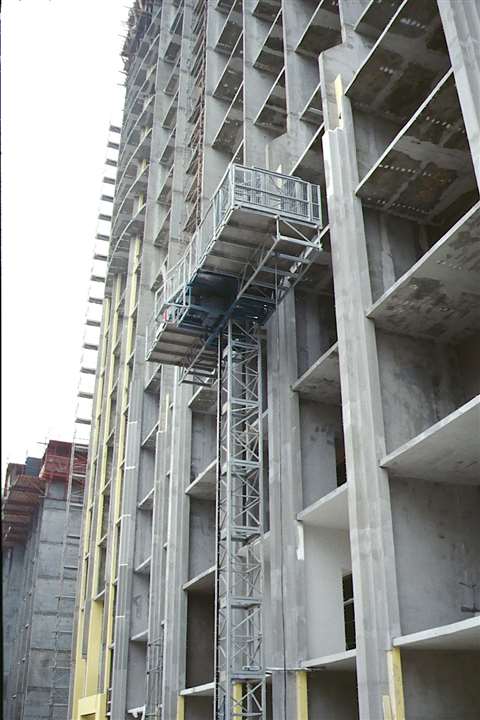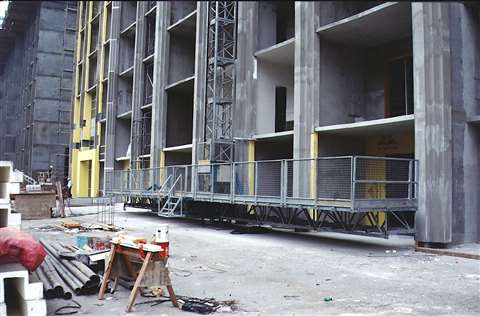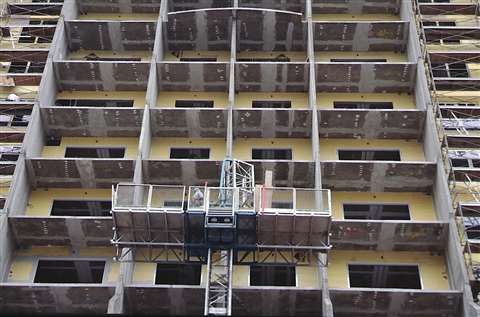Column: Mast climbers 101
27 January 2023
If you had no idea what scaffolding was, I suspect your definition of a mast climber would include something to do with sailboats or perhaps climbing flag poles. Perhaps not.
While it is plausible that sailors were climbing masts when Christopher Columbus stopped off in America in 1492, the first mast climbing scaffold didn’t show in North America until about 40 years ago; there is no creditable evidence that Columbus brought a mast climber with him.
So, what exactly is a mast climber?
That’s a good question since there isn’t necessarily an agreement between government regulatory agencies and the industry. First, the official name is mast climbing work platform (MCWP) although it is commonly just called a mast climber. Figure 1 illustrates what a mast climber is.
 A mast climbing work platform. (Photo: David Glabe)
A mast climbing work platform. (Photo: David Glabe)
The American National Standards Institute (ANSI) considers a MCWP an aerial work platform and has specific authoritative information regarding MCWPs in its standard, A92.9. The document explains that MCWP “refers to the whole of the installation, including the work platform, mast, mast ties, base and chassis.”
It defines the work platform as “the vertical traveling part of the installation upon which persons, equipment and materials are carried and from which work is carried out,” and describes the mast as “a structure that supports and guides the platform.” In simpler terms, a MCWP is a platform that rides up and down a mast/tower. You get to stand (or sit if you would like) on the platform and enjoy the ride.
MCWPs can be used in unlimited situations but the most common use is on the face of buildings and other structures.
Since the mast is the vertical support, it is designed to carry the vertical load of the platform and whatever you place on the platform. As with other temporary structures, such as a frame scaffold, the mast handles vertical loads well but it doesn’t like horizontal loads. Therefore, it is quite important that the mast is installed, and remains, in a plumb position.
It also is really important that whatever surface the mast bears on has the strength to support it. For example, if the mast is set on earth, that is the ground, a sill must be used and it must be properly designed by a qualified person to transfer the load to the ground. The good old 2x10 used for your typical scaffold won’t hack it. If, on the other hand, the mast is bearing on the floor of the building, the floor must be analyzed to ensure it is adequate to support and transfer the MCWP load to the building columns. Again, this analysis must be done by a qualified person, and for buildings and other structures it usually means a qualified Professional Engineer.
Maintaining the stability of the mast is equally critical. ANSI describes stability as “a condition in which the sum of the moments which tend to overturn the MCWP is less than the sum of the moments tending to resist overturning.” What?
In layman’s terms, stability means the mast isn’t falling over. Unfortunately, some of the more spectacular, and fatal accidents, have occurred due to the loss of stability of the mast—that is, the mast fell over. To ensure the mast won’t fall over, mast ties are employed at specified intervals on the mast.
ANSI describes the mast tie as the “anchorage system used to provide lateral restraint to the mast from the building or other structure.” These ties are not the flimsy #9 wire that is used to connect a frame scaffold to a building but are robust, purpose-designed, structural elements designed by the MCWP manufacturer for the explicit purpose of maintaining mast stability.
Therefore, it is essential that the ties designed for that specific mast climber are used. And, equally important, the ties must be installed at the locations and frequencies specified by the manufacturer. And, more equally important, the ties must never be detached during climber use.
Don’t get carried away
Consequently, ties must only be removed in the correct sequence during the mast disassembly process. Since masts come in sections, only remove ties that are necessary for the removal of specific mast sections. Accidents have occurred because the mast dismantlers got carried away and removed ties before they should have, resulting in falls and deaths.
 Maintaining the stability of the mast is critical. (Photo: David Glabe)
Maintaining the stability of the mast is critical. (Photo: David Glabe)
Platform operation is straightforward in that the platform moves up and down the mast mechanically. Since all occupants are trained prior to getting on the platform, they will know that the guardrail system is in place, the access gate is closed and only trained operators will be operating the platform, that is making the platform go up and down.
The occupants will also know the load limits and how the placement of the loads impact the allowable platform loading.
Beyond ‘general’ training
Speaking of training, the ANSI A92.9 document clearly describes the information that all users and operators of the mast climber must know. It is quite comprehensive, and you would be well-advised to consult the document before you hop on a mast climber. It goes beyond the general training requirements that are outlined in the U.S. federal Occupational Safety & Health Administration (OSHA) regulations.
This now brings us to what was alluded to in the beginning. There isn’t necessarily an agreement of what a mast climber is and therefore there is confusion as to the applicable regulations. The scaffold industry knows what a MCWP is, but OSHA maintains, in a Letter of Interpretation dated August 1, 2000, that section 1926.453 of the scaffold subpart applies only to the equipment listed in ANSI A92.2-1969.
 To ensure the mast won’t fall over, mast ties are employed at specified intervals on the mast. (Photo: David Glabe)
To ensure the mast won’t fall over, mast ties are employed at specified intervals on the mast. (Photo: David Glabe)
Mast climbing work platforms are not included in that document. Therefore, in the eyes of OSHA, a MCWP is a scaffold like a frame, systems or suspended scaffold, and must comply with the scaffold regulations found in 29 CFR 1926.451 and 452. Good luck making that work. One significant aspect of this discrepancy shows up in the regulation addressing scaffold stability, 29 CFR 1926.451(c)(1).
This regulation addresses the typical frame and systems scaffold installation. Don’t follow the OSHA regulation if the regulation conflicts with the MCWP manufacturer’s tie requirements. Follow the manufacturer, not OSHA. If you don’t have the manufacturer’s tie requirements, get them.
MCWPs are used successfully and safely every day, providing convenient access for workers. But as with any temporary elevated platform, users must be adequately trained in the equipment they are using.
The Scaffold & Access Industry Association (SAIA) offers MCWP training that instructs an operator on how to operate the MCWP safely and the SAIA also has a code of safe practices for MCWPs. It’s on the SAIA website.
Additionally, training requirements, training information, standards, and regulations are in the ANSI A92.9 standard and in the OSHA regulations. The current ANSI A92.9 standard can be obtained from the Scaffold & Access Industry Association at a very reasonable price while the OSHA regulations can be obtained at www.osha.gov.
STAY CONNECTED



Receive the information you need when you need it through our world-leading magazines, newsletters and daily briefings.
CONNECT WITH THE TEAM







